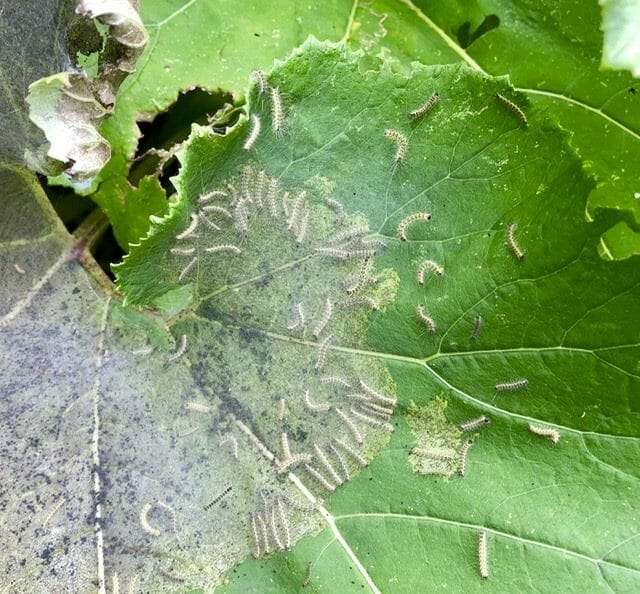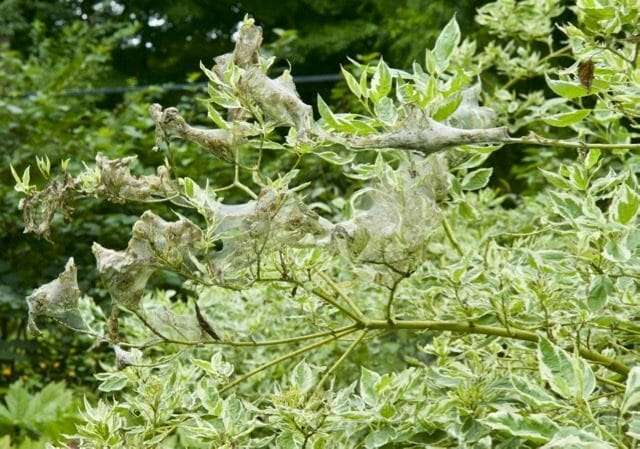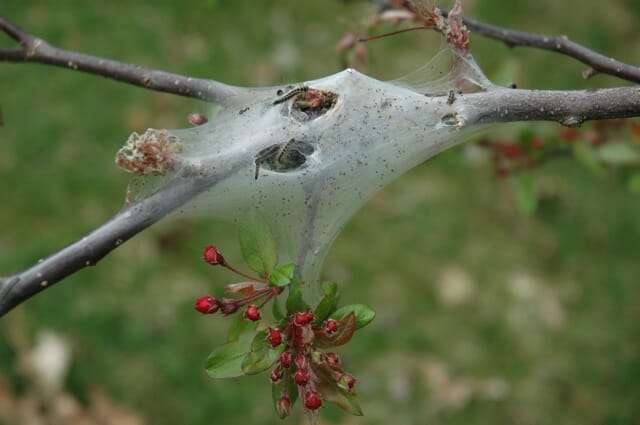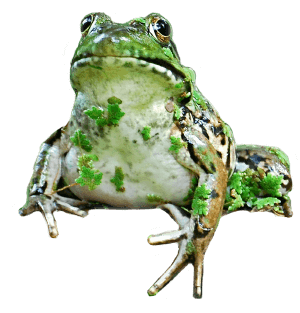what to do about fall webworm? (usually, nothing)
 IT’S A BANNER FALL WEBWORM year in my corner of the Northeast, more than I’ve seen in 30ish years here. A longtime local nurseryman friend with a U-pick apple orchard and fields of landscape trees and shrubs he grows to sell agrees: epic. What’s an organic gardener to do about fall webworm?
IT’S A BANNER FALL WEBWORM year in my corner of the Northeast, more than I’ve seen in 30ish years here. A longtime local nurseryman friend with a U-pick apple orchard and fields of landscape trees and shrubs he grows to sell agrees: epic. What’s an organic gardener to do about fall webworm?
Mostly nothing, except perhaps on the most vulnerable landscape plants—a young ornamental tree, perhaps, that might have trouble bouncing back if it suffered total defoliation.

These “fall” guys build their webs on the end of branches—unlike the Eastern tent caterpillar in springtime (another native insect you may have seen, in Malus and Prunus species in particular), which take hold in branch crotches (photo below, in a crabapple).

4 reasons i rarely intervene against fall webworm
1. This is a native insect (as are Eastern tent caterpillars I might see in spring on fruit trees, but unlike, say, imported pests like gypsy moths).
2. Fall webworms eat this season’s leaves, but not the buds that will produce next year’s foliage. Meaning: the leaves they’re eating are winding down their photosynthetic assignment for the year, anyhow—the plant doesn’t expect much more of them from here out.
3. Unlike some Lepidopteran species with very specific host plants, this one (a white moth, sometimes with dark dots) is known to do its thing on more than 90 (some sources say 80) types of woody plants. That means they’re generalists—and generalists don’t decimate one particular species of plant the way a specialist pest (think: emerald ash borer, hemlock woolly adelgid…) might in a large, targeted outbreak. A list of some of the many things they eat is here.
4. The fall webworm has many natural enemies—parasitic insects including wasps and predatory insects. Entomologists say that fact them attack fall webworms (instead of eliminating them yourself) may actually have environmental side benefits:
“In fact, fall webworm is thought to be an important late-season food source for many of these natural enemies,” says this Michigan State fact sheet (pdf), “enabling their populations to persist until the following year, when they can again prey on gypsy moths and other tree-feeding pests.” Bonus!
if intervention is required..
IF INTERVENTION is required against fall webworm on a vulnerable landscape specimen, always be safe and sane:
When webs first appear, before extensive feeding occurs, mechanical (non-chemical) control can be achieved by pruning off affected bits, or using a bamboo cane or even a stiff jet of water from the hose to dislodge the webs. Then drown the insects in a bucket of water, or squash them.
As it will with any foliar-feeding caterpillar, spraying a solution of Bacillus thuringiensis (Bt) according to product directions will kill the larvae, but not harm other insects.
Me? I’ll be over here watching in total fascination, basically.





Margaret, a timely, helpful article and an example of how we are always learning from you! I’ve been cutting webworm off my ornamentals but you’ve given me a new outlook. I will pause before I reach for the loppers next time. Thanks for all you do!!
I use my flame thrower when they get too heavy or attack my young trees. It works a treat and I don’t have to drown them.
I assume you don’t flame them while on the branches? :)
Thank you Margaret for allaying one of my late-season night-ceiling stare sessions worrying about ye olde webworm. I am using a very small amount of Neem on the leaves of my Heuchera which seem to be the only target of the worms this year, other than 2 or 3 that I squooshed on a newly planted, small Chamaecyparis ‘Fernspray’
Heuchera — hilarious! Again you need to see if they start extra early and enthusiastically on some well-positioned branch of a special ornamental tree or shrubs in case they damage it too much, but other than that and young trees/shrubs that could get engulfed, I am pretty hands-off.
A pest entered my yard for the first time since planting a yellow dogwood last year. During the day the underside of the leaves were covered with many, small, multi-patterned larva, who feed at night. I learned that they were a sawtooth wasp. By the time I noticed, most of the leaves had already been chewed, leaving quite an ugly sight. It took me days to find most of them to drown in soapy water. I wish I could send you a photo – quite a fascinating sight. Next year I’ll be more vigilant!
Hi, Beth. The dogwood sawfly larvae are very interesting looking — I have them here every year this time, too. You can see them in this old story. Since they are likewise a native insect and they do their munching late in the season, I leave them be.
As always, I like your approach Margaret. I would imagine some birds like them too. I am only finding them on mulberry trees, and did the same, just let them be. I so like having a place for whoever needs it here in moderate suburbia. Thanks for the input!
Thanks for that info. I have always ignored them. The ones I have do seem to sometimes kill whole branches or that could just be a coincidence.
Yes, certain trees and shrubs seem more vulnerable … or if they get all over one key branch too early it might be wise to intervene (move them) … always a judgment call.
Margaret, I’m so grateful to you so many days and I whisper a quiet thank you to you over the ether, but your webworm post was so what I needed to read at the moment today, I’m breaking my silence. THANK YOU !!!
I live in central Florida and have the yearly sod webworm visits on the pignut hickory tree. Always fascinating to watch the process! This year they were earlier (July/August) and so many! It was great to read your article and see that it wasn’t just here! The leaves are back out already and will probably fall off in the cooler months (December) as we’re still “cooking” here!
Hi, Beverly. For people who don’t know what sod webworm is, here is a link to some species that cause it in Florida, e.g. Thanks for adding to the conversation.
I’m so glad to see this article! I’ve been asking all my gardener friends about the onslaught of leaf eating worms this season. I’ve never had them all over from my willow tree to young spice bushes—everything! After a particularly tough year in zone 7 with temperature swings, soggy soil and muggy heat waves, I’ve worried. Now, I’ll try to relax and take your advice to watch the worms and know that that is the best thing to do.
My neighbor’s tree is infested and the branch hangs over the fence right above my vegetable garden. Can they do damage to my garden? Are my vegetables below it safe to eat?
Thanks
The picture of the moth looks like spilosoma congrua, the agreeable tiger moth, rather than a fall webworm moth.
Thanks, Gwyn. I did compare the image to ones of each species on BugGuide and since the two look so much alike when you have no reference for scale and can’t turn it over to see the colors at the throat, I took it out and put a link to images of the adult from there.
Why do these webworms crawl all over my house. It is disgusting
Nature in our area is sporadic at best being the climate engineers are screwing with the weather. I have trees near bushes near our home that trunks are rotting from the inside or being cooked from the inside since that is where most of the moisture in a tree or bush resides. We are having a major infestation of webworms this year expecially on the pecan trees in my yard, but it doesn’t seem to be a wide spread issue around the neighborhood an it looks like it by be in a line to the Northeast as far as I see for now, as that is a nearby house about 1/4 mile away and their small trees seem to be encased. I am still looking into it. they also are on my deck and sweet gum tree brances but not as much. I also found them moving about on a 55 gallon metal drum top.